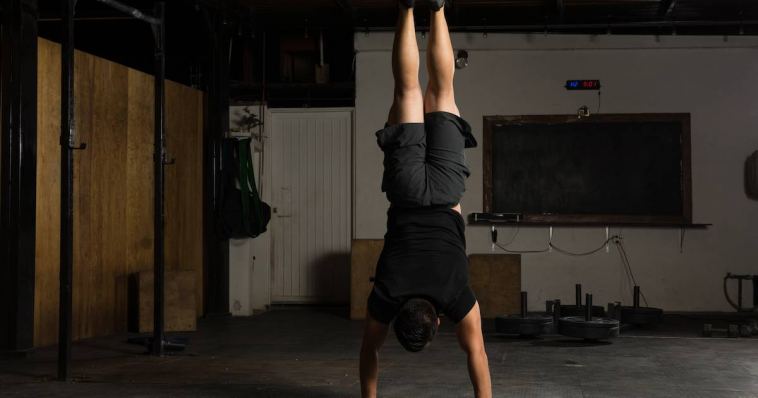- Like
- SHARE
- Digg
- Del
- Tumblr
- VKontakte
- Flattr
- Buffer
- Love This
- Save
- Odnoklassniki
- Meneame
- Blogger
- Amazon
- Yahoo Mail
- Gmail
- AOL
- Newsvine
- HackerNews
- Evernote
- MySpace
- Mail.ru
- Viadeo
- Line
- Comments
- Yummly
- SMS
- Viber
- Telegram
- JOIN
- Skype
- Facebook Messenger
- Kakao
- LiveJournal
- Yammer
- Edgar
- Fintel
- Mix
- Instapaper
- Copy Link
It’s important to know what you want from your handstand journey. The majority of us aren’t gymnasts or professional hand-balancers, so we don’t have to have a perfect handstand, whatever that is.
With social media, we can often feel disheartened because we are exposed to the very best, whose job is to have a certain handstand.
There is no competition or judges for the regular person; you are only training for yourself.
This article is for people who want to improve their kick up consistency, which means kicking up into a handstand and holding it most of the time. I know from personal experience, it’s frustrating to waste energy constantly falling and not actually holding a handstand.
It’s important to be comfortable on your hands so that you can make cool moves such as:
I call this a journey because it is. You can have the best training one day, then the next day nothing goes right.
It doesn’t matter how experienced you are. There will still be bad days. You will get better at reading your body and adjusting.
Prepare Your Wrist
I’ve discovered during my personal training career that the majority of people have weak wrists. Don’t be discouraged if this is you, but you must accept where you are. We live in a beautiful society, but it has its disadvantages, one of them is we never use our wrists.
We don’t hang, crawl, or apply pressure to them (typing on the laptop doesn’t count).
Remember, the body is efficient. Use it, or lose it. This goes for physical, technical, and mental skills.
When I used to teach big classes, I quickly realized that if I had 2-3 exercises that involved a little pressure on the wrist, the groans I heard weren’t from physical exertion but wrist pain.
When you start training your wrist, it only takes a few weeks to see improvements. How do you strengthen the wrists?
Build habits in your daily life because just doing one or two days a week is not enough, even if it’s for an hour.
I love this Bruce Lee quote:
It takes 5-15 minutes daily to get the best results or spread it throughout the day by building cues or reminders.
For example, every day before you eat or after a shower, do a set or set a timer, anything to make it convenient for yourself by incorporating it into your life.
The majority of the day is spent making habits we’ve built. It’s not a habit when it takes too much energy and willpower.
What if you don’t get wrist pain?
Wrist work is still needed.
You have to realize that handstands aren’t a natural position.
Your ankles are designed to support your full weight and gravity, but our small wrists aren’t.
That’s why strengthening the wrists, fingers, and forearms are important, and also, the elbows and shoulders.
Progress in handstands and calisthenics is determined by how strong your joints and tendons become because these small areas have to withstand the load and force passing through them.
You can find more mobility routines here Prehab/ Rehab for:
So before you go upside down, spend a week or two getting the joints ready.
When you get into handstands against the wall, there is bound to be some discomfort in the wrists (they will get stronger and adjust), but it shouldn’t be painful.
Babies Do It Every Day
There’s no perfect handstand program, but you’ll hear athletes/coaches saying their way is the best, and neither am I saying my way is the right way.
I’m sharing how I’ve taught myself and clients to balance on their hands. Everyone is different, and we all learn differently. That’s what makes the world go round.
Two components will make the difference regardless of what program or training style you apply.
The First Component Is Consistency
We hear this word all the time because, without it, there is no success. It doesn’t matter how great your training session might have been.
Training something once a week will do nothing.
You will not build the neural adaptation and spatial awareness to master the handstand.
When babies are learning how to walk/stand, they do it every day. They have the desire and curiosity to step into the unknown, learn, and adapt. That’s the kind of mindset you want to have.
You don’t have to spend hours every day, but make it a habit of being upside down. Those pockets of time when you’re bored or doing menial tasks, practice your handstand instead. Five minutes is all you need.
Heck, one set daily will do the job.
This is In addition to 2-3 training sessions (about 1 hour) a week to practice various drills and weak areas.
The Second Component Is Time on Your Hands
The second component is the actual time you spend balancing on your hands. Failing to kick up and hold the handstand can be a part of your training, but please, not the whole hour. It teaches you very little.
You need to get the most out of your training. You actually want to feel what it’s like to bear weight on your hands, shifting your center of mass and how your hands are constantly making small adjustments.
Do exercises on the wall or close to the wall, and that way, if you fall, you have support.
Some people can only hold a handstand in one particular position. I’m not talking about creating shapes with your legs because their area of influence is poor:
- If the legs go too much one way, they fall.
- If the shoulders are stiff, they fall.
- If the core breaks, they fall.
This could be that they’ve never actually spent time in those positions. How can you adjust if you don’t know what position your body is in?
Spend some time in a:
- Banana handstand (arched back)
- In a pike (are your glutes too tight, hands uneven?)
When you know what not to do, then you can correct it.
- When I was learning the handstand, I was obsessed with being in a straight line. Otherwise, it didn’t count.
- I would abort the handstand if I knew I wasn’t straight.
- This resulted in me not actually being able to navigate or adjust while being on my hands.
- My kick up was poor, and I didn’t understand what was going on.
- Then I started focusing on my hands, shoulders, and hips.
I would kick up, and whatever position my body was in, I would try and hold it.
Babies will try all different things, spending ten seconds here, then falling, another ten seconds there, and then falling.
That’s similar to a handstand journey, spend ten seconds freestanding, another 30 seconds doing a drill on the wall. Gather those valuable seconds on your hands. By doing them frequently, you will progress.
Guidelines
Don’t overcomplicate it, be consistent, and actually spend time on your hands.
Here’s a training template you can work off and adapt.
- Choose exercises to focus on the areas I’ve outlined.
- Most of the exercises you will do as a superset.
- A superset is when you perform one set of an exercise (B1) and then immediately switch to another exercise (B2).
You can rest when you have completed the set.
Handstand Session Template
Training sessions can be structured like this, or they can be irregular play.
You can change the exercises you do every month, week, or session by session.
Doing stretches during your session is good to loosen the muscles and to calm your breathing. The more relaxed you are, the better your handstands will be.
You can find a beginner handstand program here Handstand 0-60.
Flexibility and handstands go hand in hand because being able to stack your feet, hips, and shoulders on top of your hands help make handstands less draining.
Without shoulder flexibility (+180° overhead straight arm raise or backend), your wrists and forearms will take most of the load. These areas fatigue quickly under your weight.
It is much better to let the shoulder take most of the load, just like your hips do for your lower body.
Without hamstring flexibility, a forward fold, or the pancake stretch, you will be unable to control your kick up, and you will find it hard to have your legs straight in a handstand.
You can train your flexibility together or separately from your handstands.
There’s No Perfect Handstand
There’s no perfect handstand. There’s just the desire and curiosity to step into the unknown, learn, and adapt.
Spend five minutes a day on your hands and train 2-3 times a week, working on drills to improve your balance, endurance and kick up consistency.
You can always improve your alignment along the way. Take care of your joints because they will determine how far you can advance.




